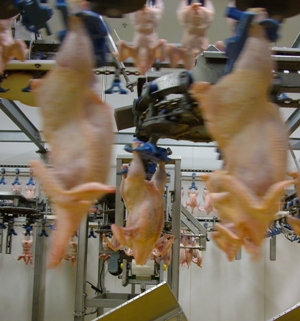Zinc minimises downgrading due to skin scratches

Poultry processing companies all around the world worry about the level of carcass downgrades due to skin lesions. Nutritional and management strategies can reduce the incidence of this predominantly health, but also ethical and aesthetic concern.
By Wiebe van der Sluis, Rooster 45, Doetinchem, the Netherlands
The skin protects the bird against microbial and physical influences from the environment. It is the largest single structure in the regulation of the bird’s body temperature. Although the skin is continuously renewed and has a very high ability to recover from injuries, it may leave visible scars. Initially scratches are most of the time open wounds and allow bacteria to penetrate into the skin. Here they may cause cellulitis and gangrenous dermatitis, which will result in severe losses in meat yield due to increased (up to 7.0%; USA figure) condemnations. Broiler processors have traditionally battled scratching problems in the spring-summer months when light intensity affects flock activity and warm weather negatively impacts bird feathering.
Vitamin and/or mineral inclusions in feed may help in calming birds during times of stress. Vitamin C reduces stress hormone levels resulting in lessening fear responses. Extra dietary vitamin E allows the bird to combat E.coli bacteria to multiply under the skin after gaining entry through a scratch. Trials with increased levels of magnesium and sodium, both known for calming birds, showed positive results. However the associated increase in water consumption caused unacceptable wet litter problems.
Ten years ago Dr. Joe Hess and Prof. Sarge Bilgili of the Auburn University already suggested in Broiler Industry that by boosting the bird’s immune function the severity infections resulting from skin lesions could be reduced. They recommended utilising chelated zinc products, particularly those complexed with amino acids, due to their ability to strengthen skin and quickly heal any scratches that develop. Complexed zinc has shown to boost cellular and humoral immunity, increasing the bird’s ability to fight off skin infections that may slow the healing process. Given zinc’s role in skin integrity and healing, these complexed sources may have a role in reducing skin-quality related downgrades.
Improved skin integrity
The importance of zinc in maintaining and improving skin integrity has been confirmed by recent studies at Auburn University. They showed that the proportion of skin lesions decreased from 42.7% in birds given inorganic zinc sulphate to 9.6% in birds given complexed zinc in their feed (Figure 1). It was also confirmed that broilers fed complexed zinc had decreased skin tears and scratches resulting in less incidents and severity of cellulitis (Figure 2).
Besides improvements in skin quality (including bird health) and reductions in condemnations, Auburn researchers also discovered major performance advantages when supplementing complexed zinc to broiler rations. They showed significant improvements in body weight (3,241 vs. 3,140g) and feed conversion (1.701 vs. 1.736) compared to ordinary zinc sulphate, while there was no effect on total mortality. No differences in carcass and component yields were detected. However, as Auburn researcher B. Saenmahayak stated at the 2008 International Poultry Scientific Forum in Atlanta, “Deboned fillet and total breast yields were significantly higher in complexed zinc than in ordinary zinc sulphate treatment, while breast fillet quality attributes did not show any differences between the treatments.” These findings show that the level and source of dietary zinc have a significant influence on broiler live and processing performance, as well as on the quality and appearance of broiler carcasses and fresh in skin products.













